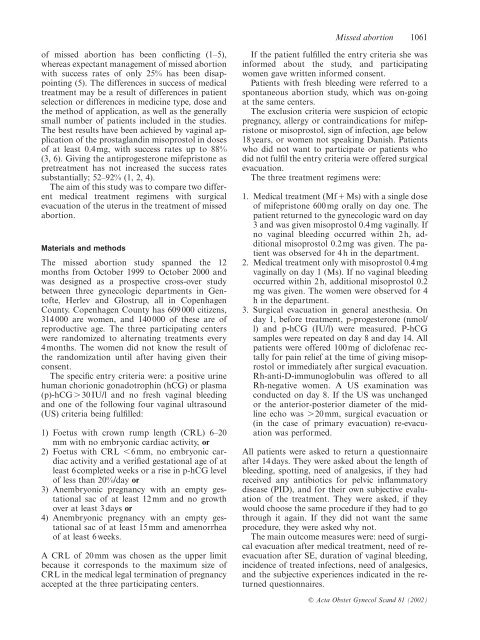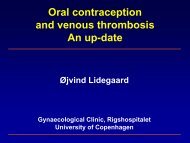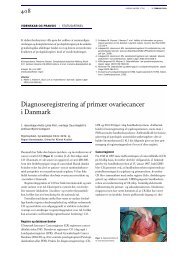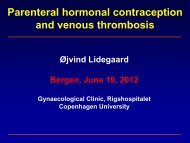Management of missed abortion: comparison of ... - Lidegaard.dk
Management of missed abortion: comparison of ... - Lidegaard.dk
Management of missed abortion: comparison of ... - Lidegaard.dk
You also want an ePaper? Increase the reach of your titles
YUMPU automatically turns print PDFs into web optimized ePapers that Google loves.
Missed <strong>abortion</strong> 1061<br />
<strong>of</strong> <strong>missed</strong> <strong>abortion</strong> has been conflicting (1–5),<br />
whereas expectant management <strong>of</strong> <strong>missed</strong> <strong>abortion</strong><br />
with success rates <strong>of</strong> only 25% has been disappointing<br />
(5). The differences in success <strong>of</strong> medical<br />
treatment may be a result <strong>of</strong> differences in patient<br />
selection or differences in medicine type, dose and<br />
the method <strong>of</strong> application, as well as the generally<br />
small number <strong>of</strong> patients included in the studies.<br />
The best results have been achieved by vaginal application<br />
<strong>of</strong> the prostaglandin misoprostol in doses<br />
<strong>of</strong> at least 0.4 mg, with success rates up to 88%<br />
(3, 6). Giving the antiprogesterone mifepristone as<br />
pretreatment has not increased the success rates<br />
substantially; 52–92% (1, 2, 4).<br />
The aim <strong>of</strong> this study was to compare two different<br />
medical treatment regimens with surgical<br />
evacuation <strong>of</strong> the uterus in the treatment <strong>of</strong> <strong>missed</strong><br />
<strong>abortion</strong>.<br />
Materials and methods<br />
The <strong>missed</strong> <strong>abortion</strong> study spanned the 12<br />
months from October 1999 to October 2000 and<br />
was designed as a prospective cross-over study<br />
between three gynecologic departments in Gent<strong>of</strong>te,<br />
Herlev and Glostrup, all in Copenhagen<br />
County. Copenhagen County has 609000 citizens,<br />
314 000 are women, and 140000 <strong>of</strong> these are <strong>of</strong><br />
reproductive age. The three participating centers<br />
were randomized to alternating treatments every<br />
4 months. The women did not know the result <strong>of</strong><br />
the randomization until after having given their<br />
consent.<br />
The specific entry criteria were: a positive urine<br />
human chorionic gonadotrophin (hCG) or plasma<br />
(p)-hCG30 IU/l and no fresh vaginal bleeding<br />
and one <strong>of</strong> the following four vaginal ultrasound<br />
(US) criteria being fulfilled:<br />
1) Foetus with crown rump length (CRL) 6–20<br />
mm with no embryonic cardiac activity, or<br />
2) Foetus with CRL 6 mm, no embryonic cardiac<br />
activity and a verified gestational age <strong>of</strong> at<br />
least 6 completed weeks or a rise in p-hCG level<br />
<strong>of</strong> less than 20%/day or<br />
3) Anembryonic pregnancy with an empty gestational<br />
sac <strong>of</strong> at least 12 mm and no growth<br />
over at least 3 days or<br />
4) Anembryonic pregnancy with an empty gestational<br />
sac <strong>of</strong> at least 15 mm and amenorrhea<br />
<strong>of</strong> at least 6 weeks.<br />
A CRL <strong>of</strong> 20 mm was chosen as the upper limit<br />
because it corresponds to the maximum size <strong>of</strong><br />
CRL in the medical legal termination <strong>of</strong> pregnancy<br />
accepted at the three participating centers.<br />
If the patient fulfilled the entry criteria she was<br />
informed about the study, and participating<br />
women gave written informed consent.<br />
Patients with fresh bleeding were referred to a<br />
spontaneous <strong>abortion</strong> study, which was on-going<br />
at the same centers.<br />
The exclusion criteria were suspicion <strong>of</strong> ectopic<br />
pregnancy, allergy or contraindications for mifepristone<br />
or misoprostol, sign <strong>of</strong> infection, age below<br />
18years, or women not speaking Danish. Patients<br />
who did not want to participate or patients who<br />
did not fulfil the entry criteria were <strong>of</strong>fered surgical<br />
evacuation.<br />
The three treatment regimens were:<br />
1. Medical treatment (MfπMs) with a single dose<br />
<strong>of</strong> mifepristone 600mg orally on day one. The<br />
patient returned to the gynecologic ward on day<br />
3 and was given misoprostol 0.4mg vaginally. If<br />
no vaginal bleeding occurred within 2h, additional<br />
misoprostol 0.2mg was given. The patient<br />
was observed for 4h in the department.<br />
2. Medical treatment only with misoprostol 0.4 mg<br />
vaginally on day 1 (Ms). If no vaginal bleeding<br />
occurred within 2h, additional misoprostol 0.2<br />
mg was given. The women were observed for 4<br />
h in the department.<br />
3. Surgical evacuation in general anesthesia. On<br />
day 1, before treatment, p-progesterone (nmol/<br />
l) and p-hCG (IU/l) were measured. P-hCG<br />
samples were repeated on day 8 and day 14. All<br />
patients were <strong>of</strong>fered 100mg <strong>of</strong> dicl<strong>of</strong>enac rectally<br />
for pain relief at the time <strong>of</strong> giving misoprostol<br />
or immediately after surgical evacuation.<br />
Rh-anti-D-immunoglobulin was <strong>of</strong>fered to all<br />
Rh-negative women. A US examination was<br />
conducted on day 8. If the US was unchanged<br />
or the anterior-posterior diameter <strong>of</strong> the midline<br />
echo was 20mm, surgical evacuation or<br />
(in the case <strong>of</strong> primary evacuation) re-evacuation<br />
was performed.<br />
All patients were asked to return a questionnaire<br />
after 14days. They were asked about the length <strong>of</strong><br />
bleeding, spotting, need <strong>of</strong> analgesics, if they had<br />
received any antibiotics for pelvic inflammatory<br />
disease (PID), and for their own subjective evaluation<br />
<strong>of</strong> the treatment. They were asked, if they<br />
would choose the same procedure if they had to go<br />
through it again. If they did not want the same<br />
procedure, they were asked why not.<br />
The main outcome measures were: need <strong>of</strong> surgical<br />
evacuation after medical treatment, need <strong>of</strong> reevacuation<br />
after SE, duration <strong>of</strong> vaginal bleeding,<br />
incidence <strong>of</strong> treated infections, need <strong>of</strong> analgesics,<br />
and the subjective experiences indicated in the returned<br />
questionnaires.<br />
C Acta Obstet Gynecol Scand 81 (2002)









